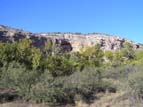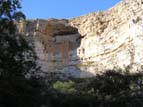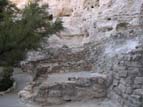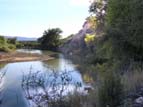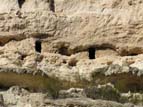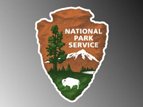Montezuma Castle National Monument is located about 50 miles south of Flagstaff, only two miles east of I-17. Operated by the National Park Service, it has a well-maintained access road, a gift shop and interpretive center, and hard-surfaced, wheelchair-accessible walking paths leading from the parking lot. There is an entry fee ($5.00 per person at the time of this writing), it is not open after dark, and visitors are no longer allowed up inside the actual ruins. It is, however, perhaps the best-preserved cliff dwelling in North America, and is well worth a visit.
Motezuma's Castle is a five-story cliff dwelling consisting of about twenty rooms, built into an alcove 100 feet above the floor of Beaver Creek Canyon (Photos 1 thru 5). The ruin faces south, a characteristic of most cliff dwellings that allows them to catch and retain as much warmth from the sun as possible. The cliff face into which the structure is built consists of a whitish, fairly soft limestone that has weathered to produce numerous alcoves and caves, many of which have been walled off to create living or storage spaces (photo 8).
A few dozen yards to the west of Montezuma Castle is a second ruin. Dubbed "Site A" or "Castle A" by archeologists, this ruin was once even larger than the Castle itself, consisting of 40 to 45 rooms. Constructed in a series of terraces up against the face of the cliff, it was not as well protected from the elements as the Castle. There is also evidence that the structure was razed by fire sometime near the end of its occupation. All that is left now are the outlines of the ground-level foundations, and some walled-off alcoves further up the cliff face (Photo 8).
The walls of Montezuma Castle are built of fieldstones held together with a mortar of mud and clay. "Fieldstones" are rocks that have not been worked, or that have been worked only to the extent that they may have been broken from larger pieces, or had some inconvenient nubs lopped off to make them fit more closely. Interior and exterior walls are covered with a layer of mud "plaster" about an inch thick, to produce a relatively smooth surface and protect the load-bearing components from weathering.
Internal floors are supported by large logs up to a foot in diameter and spaced three to four feet apart. A layer of smaller logs, four to six inches in diameter and separated by eight to twelve inches, is laid crosswise over the main beams; and then a solid layer of branches of one to two inch thickness is laid crosswise on top of that. This is covered by a mat consisting of grasses, bark and very small branches, and finally the entire arrangement is covered over with three or four inches of mud and clay. This technique produces very solid floors that have stood for the better part of a thousand years.
Several architectural details of Montezuma Castle have raised questions about the extent of trade routes and cultural influence in the southwest. For example, the T-shaped doors found in some parts of the ruin are characteristic of the Anasazi Great Houses in the Four-Corners area to the northeast. Trade goods found at the site, including pottery, feathers from exotic birds, and seashells, also indicate extensive trade and communications with neighboring cultures.
Montezuma Castle is located in the Verde Valley of central Arizona, along a tributary of the Verde River called Beaver Creek. The Verde Valley provides a natural corridor and trade route between the southern desert and the northern plateau, and has been inhabited at different times by several different cultures.
There is evidence of Paleo-Indian hunter-gatherers in some parts of Arizona that date as far back as ten thousand years. In the Verde Valley, there is direct archeological evidence of human habitation dating back only about two thousand years, although it is almost certain that people were there long before that.
From about 600 to 1100 AD the region was occupied by a people with ties to the Hohokam, a major culture centered around present-day Phoenix. The remains of pithouses—one-room structures built of rock, mud, poles and sticks characteristic of the Hohokam culture—can still be found in the area. One such pithouse is on display at Montezuma Well, five miles to the northeast of Montezuma Castle along Beaver Creek.
Around 1100 AD the region began to see an influx of Sinagua from the north. All of the large, multi-roomed complexes in the Verde Valley, including Motezuma Castle, Montezuma Well, Tuzigoot, the cliff dwellings around Sedona, and Walnut Canyon near Flagstaff date from about that time. Montezuma Castle itself was constructed and occupied during the period 1200 to 1450.
Most of these sites were continuously inhabited by the Sinagua for approximately three hundred years. They were all abandoned between 1400 and 1450 AD, a period that marks the collapse of all the major civilizations in the southwest, including the Sinagua, Hohokam, Salado, Mogollon, and Anasazi. The reasons for this regional collapse have never been fully understood. Possible explanations include an extended period of drought, disease, the exhaustion of farmlands due to non-sustainable agricultural techniques, and war.
The name "Montezuma Castle" was coined by early white settlers in the mistaken belief that the ruins were associated with Montezuma. (Montezuma was the ruler of the Aztec empire from 1502 to 1520, the beginning of the Spanish conquest of Mexico.)
Although known to locals for many years, the site was not investigated in a scientific manner until the late 1800s, at which time certain sections were already in danger of collapse. The Arizona Antiquarian Association undertook some emergency repairs between 1896 and 1900, but little other official attention was paid until Theodore Roosevelt declared both Montezuma Castle and Montezuma Well a national monument in 1906. In 1927 the National Park Service undertook a major stabilization project, in an attempt to repair damage done by almost a century of uncontrolled looting and digging by treasure hunters. Tourists were allowed to enter the ruin via a series of wooden ladders up until 1951. Today access is allowed only for official reasons.
Although the Castle has undergone several rounds of reconstruction and stabilization over the last hundred years, over ninety percent of the structure is original.
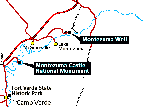
Map
Map showing the locations of Montezuma Castle, Montezuma's Well, and Tuzigoot, all operated by the National Park Service and open to the public.

